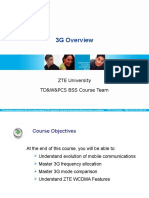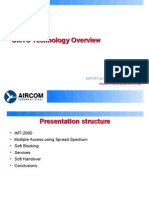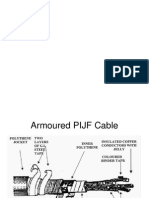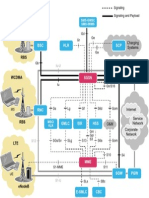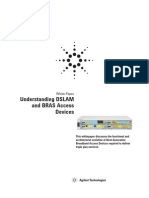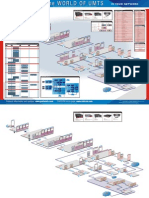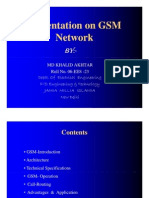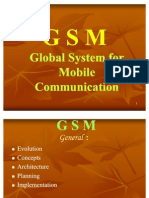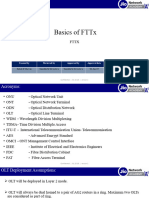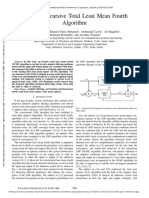GSM Fund
GSM Fund
Uploaded by
Cemil BinlikCopyright:
Available Formats
GSM Fund
GSM Fund
Uploaded by
Cemil BinlikOriginal Description:
Original Title
Copyright
Available Formats
Share this document
Did you find this document useful?
Is this content inappropriate?
Copyright:
Available Formats
GSM Fund
GSM Fund
Uploaded by
Cemil BinlikCopyright:
Available Formats
GSM Fundamentals
GSM Fundamentals
Asiacell Telecom Platform Course
GSM Fundamentals
Contents
Basic Concepts of Cellular Mobile System
GSM Network Components
Terrestrial Interface
Service Area and Number Planning
Channels on The Air Interface
Radio Techniques
The Future Development
Asiacell Telecom Platform Course
GSM Fundamentals
GSM Development
1989
Standard Protocol for GSM take effect
1991
GSM system began to provide service in Europe(2G)
1992
System was named as Global System for
Mobile Communication
1994
Provide services for the whole world
1996
Micro Cell Technique is used in GSM system
Asiacell Telecom Platform Course
GSM Fundamentals
The Frequency Spectrum
Downlink
Uplink
EGSM
880
GSM
890
EGSM
915
925
Channel Bandwidth: 200KHz
935
GSM
960
MHz
Duplex Separation: 45 MHz
Asiacell Telecom Platform Course
GSM Fundamentals
Frequency Spectrum in GSM System
ARFCN: Absolute Radio Frequency Channel Number
Asiacell Telecom Platform Course
GSM Fundamentals
Frequency Allocation in Iraq
ARFCN: Absolute Radio Frequency Channel Number
Asiacell Telecom Platform Course
GSM Fundamentals
Cell Structure
Omni Cell
Sector Cell
1
120
degree
120
degree
Asiacell Telecom Platform Course
120
degree
GSM Fundamentals
Cell Structural in Sulymaniyah
Asiacell Telecom Platform Course
GSM Fundamentals
Frequency Re-Use
What is Frequency Re-Use?
Because frequency resource of mobile system is
very limited,
The different Subscribers must use the same
frequency in different place.
Of course, the quality of communication must be
ensured.
Asiacell Telecom Platform Course
GSM Fundamentals
Frequency Re-Use
How can we reuse frequency?
7(Site)X 1(Cell)
Re-use
2
7
2
2
3
1
6
1
6
2
3
4
5
Asiacell Telecom Platform Course
10
GSM Fundamentals
Frequency Re-Use
4(Site)X 3(Cell)
7
3
Re-use
11
1
9
12
6
2
3
5
11
10
12
4
9
6
2
3
10
11
8
4
6
2
Asiacell Telecom Platform Course
10
12
11
GSM Fundamentals
Contents
Basic Concepts of Cellular Mobile System
GSM Network Components
Terrestrial Interface
Service Area and Number Planning
Channels on The Air Interface
Radio Techniques
The Future Development
Asiacell Telecom Platform Course
12
GSM Fundamentals
GSM Network Components
M2000 Server
PSTN
ISDN
MS
BTS
BSC
MSC/VLR
GMSC
MS
MS
BTS
BTS
MS
MS
Other PLMN
BSC
SS7
BTS
SMS system
HLR/AUC
Asiacell Telecom Platform Course
13
GSM Fundamentals
Mobile StationMS
MS=ME+SIM
International Mobile Equipment
Identity (IMEI)
Mobile Equipment
International Mobile Subscriber
Identity (IMSI)
Subscriber Identity Module
Asiacell Telecom Platform Course
14
GSM Fundamentals
Subscriber Identity Module SIM
International Mobile Subscriber
Identity (IMSI)
Temporary Mobile Subscriber
Identity (TMSI)
Location Area Identity (LAI)
Subscriber Authentication Key
(Ki)
* PIN and PUK are used to SIM security
Asiacell Telecom Platform Course
15
GSM Fundamentals
Base Station Subsystem (BSS)
- Base Station Controller (BSC)
- Base Transceiver Station (BTS)
- Transcoder and Sub multiplexer (TCSM)
or Transcoder and Rate Adaptation Unit (TRAU)
BTS
BSC
TCSM
MSC/VLR
MS
BTS
MS
BSS
Asiacell Telecom Platform Course
16
GSM Fundamentals
Base Transceiver Station (BTS)
BTS
(Base Transceiver Station):
Transmit & Receive signal with MS then transfer to Base Station
Controller (BSC)
Signal Process: Speech Coding, Channel Coding, Interleaving,
Ciphering, Modulation
However, one BTS has coverage area limited. Size of coverage
area depend on population of subscriber.
A unit of coverage area is called Cell
BTS
BTS
BTS
MS
BTS
BSC
Asiacell Telecom Platform Course
MS
17
GSM Fundamentals
Base Station Controller (BSC)
BSC:
Store cell information and parameter: eg. Cell ID, BSIC, Cell
frequency (ARFCN), Output power
Control BTS to process: eg. Call set up, Handover Process,
Frequency Hopping, Power Control.
Receive BTS alarm and send BTS & BSC alarm to OMC
Measurement traffic statistic
Remote BTS O&M via BSC
BSC
BTS
MS
BTS
BSC
Asiacell Telecom Platform Course
MS
18
GSM Fundamentals
Transcoder and Sub-Multiplexer
Asiacell Telecom Platform Course
19
GSM Fundamentals
Network Switching System (NSS)
MSC/VLR
NSS
GMSC
EC
EC
SS7
BSS
PSTN
ISDN
Other PLMN
IWF
IWF
EIR
EIR
HLR/AUC
MSC = Mobile Switching Center
GMSC = Gateway MSC
HLR = Home Location Register
IWF = Inter-Working Function
VLR = Visitor Location Register
AuC = Authentication Center
EIR = Equipment Identity Register
EC = Echo Canceller
Asiacell Telecom Platform Course
20
GSM Fundamentals
Mobile Service Switching Center
MSC
Call Processing
Operations and Maintenance
Support
Inter-network & Inter-working
Billing
Asiacell Telecom Platform Course
21
GSM Fundamentals
Home Location Register (HLR)
Subscriber ID (IMSI and MSISDN)
Current subscriber VLR (current location)
Supplementary service information
Subscriber status (registered/deregistered)
Authentication key and AuC functionality
Asiacell Telecom Platform Course
22
GSM Fundamentals
Visitor Location Register VLR
Mobile Status (IMSI detached/ attached / busy /
idle etc)
Location Area Identity(LAI)
Temporary Mobile Subscriber Identity (TMSI)
Mobile Station Roaming Number (MSRN)
Asiacell Telecom Platform Course
23
GSM Fundamentals
Equipment Identity Register EIR
White List
Black List
Grey List
IMEI
Is Checked against White List
If NOT found
EIR focus on the
equipment, not the
subscriber!!
IMEI
Is Checked against Black/Grey List
Asiacell Telecom Platform Course
24
GSM Fundamentals
Authentication Center (AuC)
AUC
IMSI(m)
KI M
)
KI N
)
KI(IMSI)
IMSI(n)
RAND
GENERATOR
RAND
HLR
VLR
A8 A3
KC
SI
M
AUTH REQ
SRES
KI(IMSI)
IMSIBUFFER
RAND KC SRES
RAND KC SRES
RAND KC
SRES
1
2
RAND
KC
TEMP
DATA
SRES SRES
RAND
BSS
A8 A3
KC SRES
EQUAL
KI I MSI +RAND A3 SRES
KI ( I MSI ) +RAND A8 KC
M+KC A5
KC( M)
( MS/ BSS)
A5
KC( M) +KC ( MS/ BSS) M
CKSN
Asiacell Telecom Platform Course
RAND 16byte
KI 16byte
kc 8byte
SRES 4byte
CKSN low 3bits of 1byte
25
GSM Fundamentals
Inter-Working Function IWF
Rate Conversion
Protocol Adaptation
PSTN
MSC
MSC
EC
EC
Eg. Fax, Modem
Asiacell Telecom Platform Course
IWF
26
GSM Fundamentals
Echo Canceller EC
Echo takes place by GSM system delay caused by call processing,speech
encoding and decoding etc.
An Echo Canceller is used on the PSTN side of the MSC for all voice circuits
4-wire
2- wire
2-wire
Hybrid
Hybrid
Generation of Echo at 2-wire to 4-wire Interface
Asiacell Telecom Platform Course
27
GSM Fundamentals
Operation and Maintenance Sub System
NOC
OMC
Region2
OMC
OMC
Region 3
Region 1
Asiacell Telecom Platform Course
28
GSM Fundamentals
OMC Functional Architecture
Security
Management
Event/Alarm
Management
MMI
OS
DB
Fault
Management
Configuration
Management
Performance
Management
Asiacell Telecom Platform Course
29
GSM Fundamentals
Example: Baghdad OMC
Asiacell Telecom Platform Course
30
GSM Fundamentals
Contents
Basic Concepts of Cellular Mobile System
GSM Network Components
Terrestrial Interface
Service Area and Number Planning
Channels on The Air Interface
Radio Techniques
The Future Development
Asiacell Telecom Platform Course
31
GSM Fundamentals
GSM Interface
D
G
VLR
VLR C
HLR
H
AUC
MSC
IWF
MSC
E
EC
EC
EIR
IWF
A
TC
MS
Um
BTS
Abis
Asiacell Telecom Platform Course
BSC
32
GSM Fundamentals
GSM Protocol Stack
CM: Call Management
LAPDm: LAPD modified
MTP: Message Transfer Part
LAPD: Link Access Procedure on D Channel SCCP: Signaling Connection Control Part
MM: Mobility Management
RR: Radio Resource Management BTSM: BTS Site Management
BSSMAP: BSS Management Application Part
Asiacell Telecom Platform Course
33
GSM Fundamentals
ITU Signaling System CCS7
CCS7 Levels
MAP
OSI Layers
7. Application
6. Presentation
TUP
ISUP
TCAP
5. Session
(DTAP+BSSMAP)
SCCP
4. Transport
MTP Level 3
3. Network
2. Link
1 Physical
BSSAP
MTP Level 2
MTP Level 1
Asiacell Telecom Platform Course
2 Mb/s Trunk
34
GSM Fundamentals
Abbreviation of CCS7
MTP
TCAP
Part
SCCP
TUP
ISUP
MAP
BSSAP
BSSMAP
DTAP
Message Transfer Part
Transaction Capabilities Application
Signaling Connection Control Part
Telephone User Part
ISDN User Part
Mobile Application Part
Base Station System Application Part
BSS Management Application Part
Direct Transfer Application Part
Asiacell Telecom Platform Course
35
GSM Fundamentals
2MBps Trunks
Typical Configuration
TS 0
TS 1-15
TS16
TS 17-31
TS = Time slot
TS#
0
1-15
16
Used for
Synchronization / Clock
Traffic
CCS7 Signaling (Other TS may also the used)
17-31 Traffic
Asiacell Telecom Platform Course
36
GSM Fundamentals
SigL1: 2MBps Trunks
HLR
AUC
EIR
OMC
IWF
MSC/VLR
MSC/VLR
EC
EC
TC
PSTN
BSC
BTS
BTS
BTS
Asiacell Telecom Platform Course
37
GSM Fundamentals
CCS7 Interface
Asiacell Telecom Platform Course
38
GSM Fundamentals
LAPD Interface
Asiacell Telecom Platform Course
39
GSM Fundamentals
Contents
Basic Concepts of Cellular Mobile System
GSM Network Components
Terrestrial Interface
Service Area and Number Planning
Channels on The Air Interface
Radio Techniques
The Future Development
Asiacell Telecom Platform Course
40
GSM Fundamentals
Service Area
System area
PLMN
PLMN service
service area
area
MSC service area...
Location area...
Base station area...
Radio cell
......
PLMN service area
MSC service area...
Location area...
Base station area...
......
Radio cell
......
Asiacell Telecom Platform Course
41
GSM Fundamentals
MSC/VLR Number
CC
NDC
LSP
MSC/VLR number
The format is CC+NDC+LSP
CC Country Code.
For example: The CC of Iraq is 964".
NDC National Destination Code.
For example: The NDC of AsiaCell is 770.
LSP (locally significant part): is defined by Telecom operator.
For example: 964-770-1144002
Asiacell Telecom Platform Course
42
GSM Fundamentals
HLR Number
The format is CC + NDC + LSP.
CC Country Code.
For example: The CC of Iraq is 964".
NDC National Destination Code.
For example: The NDC of Asiacell is 770
LSP (locally significant part): is defined by
Telecom operator.
For example: 964-770-1144001.
Asiacell Telecom Platform Course
43
GSM Fundamentals
LAI
MCC
MNC
LAC
Location Area Identification
The LAI is the international code for a location area.
MCC Mobile Country Code It consists of 3 digits .
For example: The MCC of Iraq is 418"
MNC Mobile Network Code It consists of 2 digits .
For example: The MNC of Asiacell is "05"
LAC Location Area Code It is a two bytes BCD
code(hex).
The value 0000 and FFFF is invalid.
For example: 418-05-12AB
E.164 = CC + NDC + (MSC/VLR, HLR, MSISDN)
E.212 = MCC + MNC + (IMSI)
Asiacell Telecom Platform Course
44
GSM Fundamentals
CGI
CGI: Cell Global Identification
The CGI is a unique international identification for a
cell
The format is LAI+CI
LAI: Location Area Identification
CI Cell Identity. This code uses two bytes BCD
code(hex) to identify the radio cells within an LAI.
For example : 418-05-12AB-CD98
Asiacell Telecom Platform Course
45
GSM Fundamentals
BSIC
BSIC Base Station Identification Color Code)
NCC
BCC
BSIC
NCC PLMN network color code. It comprises 3 bit. It
allows various neighboring PLMNs to be distinguished.
BCC BTS color code. It comprises 3 bit. It allows
distinction between different radio frequency channels
using the same frequency in neighboring cells.
Asiacell Telecom Platform Course
46
GSM Fundamentals
MSISDN
CC
NDC
SN
National (significant)
Mobile number
Mobile station international
ISDN number
CC Country Code. For example: The CC of Iraq is 964".
NDC National Destination Code. For example: The NDC of
Asiacell is 770.
SN Subscriber Number. Format:H0 H1 H2 ABCD
Example: 964-770-110-5246
Asiacell Telecom Platform Course
47
GSM Fundamentals
IMSI
Not more than 15 digits
3 digits
2 digits
MCC
MNC
MSIN
NMSI
IMSI
MCC Mobile Country Code It consists of 3 digits .
For example: The MCC of Iraq is 418"
MNC Mobile Network Code It consists of 2 digits .
For example: The MNC of Asiacell is "05"
MSIN Mobile Subscriber Identification Number. H1H2H3
ABCDEFG
For example: 000-1600123
NMSI National Mobile Subscriber Identification MNC and MSIN
form it together.
For Example of IMSI : 418-05-000-1600123
Asiacell Telecom Platform Course
48
GSM Fundamentals
TMSI
TMSI: Temporary Mobile Subscriber Identification)
The TMSI is assigned only after successful
subscriber authentication.
The VLR controls the allocation of new TMSI
numbers and notifies them to the HLR.
TMSI is used to ensure that the identity of the
mobile subscriber on the air interface is kept
secret.
The TMSI consists of 4 bytes( 8 HEX numbers)
and determined by the telecom operator.
Asiacell Telecom Platform Course
49
GSM Fundamentals
IMEI
IMEI: International Mobile Station Equipment Identification
TAC
FAC
SNR
SP
IMEI
TAC Type approval code, 6 bit. It is administered by the type
approval center.
FAC Final assembly code, 2 bit. It is administered by the
manufacturer.
SNR Serial number, 6 bits. It is issued by the manufacturer
of the MS.
SP 1 bit, Not used.
Check IMEI by *#06#
Asiacell Telecom Platform Course
50
GSM Fundamentals
MSRN/HON
MSRN: Mobile Subscriber Roaming Number
HON: Hand-over Number
The MSRN is used to route the call to the MSC which MS
is currently located.
The HON is used by the MSC-A to set up a connection to
the MSC-B during handover process
Usually, MSRN and HON share the same numbering plan.
The format is CC+NDC+individual number. CC and NDC
is the same as that of MSISDN. The individual number is
taken from a pool of numbers specially reserved for
MSRN.
Asiacell Telecom Platform Course
51
GSM Fundamentals
Contents
Basic Concepts of Cellular Mobile System
GSM Network Components
Terrestrial Interface
Service Area and Number Planning
Channels on The Air Interface
Radio Techniques
The Future Development
Asiacell Telecom Platform Course
52
GSM Fundamentals
Multiple Access Technique
Multiple
Access Technique allows many subscribers to
use the same communication medium.
There
are
three
kinds
of
basic
Multiple Access
Technique : FDMA , TDMA and CDMA.
GSM
system adopt FDD-TDMA (FDMA and TDMA
together).
Asiacell Telecom Platform Course
GSM Fundamentals
FDMA
FDMA
uses different frequency
channels
Frequency
to
accomplish
communication.
The
whole frequency spectrum
available is divided into many
individual
channels
(for
transmitting
and
receiving) every channel can
Time
support
the
subscriber
information.
Asiacell Telecom Platform Course
or
traffic
some
for
one
control
GSM Fundamentals
TDMA
TDMA
Frequency
accomplishes
communication
in
the
different
timeslot.
A
carrier is divided into channels
based on time. Different signals
occupy
different
timeslots
in
certain sequence , that is , many
Time
signals are transmitted on the
same frequency in different time.
Asiacell Telecom Platform Course
GSM Fundamentals
CDMA
CDMA
Frequency
Code
accomplishes
communication
in
the
different
code sequences.
Special
before
coding is adopted
transmission,
then
different information will lose
nothing after
being mixed
and transmitted together on
Time
the same frequency and at
the same time.
Asiacell Telecom Platform Course
GSM Fundamentals
Physical Channel and Logical Channels
The physical channel is the medium over which the
information is carried: 200KHz and 0.577ms
The logical channel consists of the information carried
over the physical channels
1 2
Timeslot
3 4
5 6
7 0
1 2
The
Theinformation
informationcarried
carriedin
inone
onetime
time
slot
slotis
iscalled
calledaaburst
burst
TDMA FRAME
Asiacell Telecom Platform Course
TDMA FRAME
57
GSM Fundamentals
Two types of Logical Channel
Traffic Channel (TCH) :
Transmits traffic information, include data
and speech.
Control Channel (CCH) :
Or Signaling Channel, transmits all kinds of
control information.
Asiacell Telecom Platform Course
GSM Fundamentals
Traffic Channel (TCH)
TCH
Traffic Channels
Normal Burst
Speech
TCH/FS
TCH/HS
TCH Traffic Channel
TCH/FS Full rate Speech Channel
TCH/HS Half rate Speech Channel
TCH/9.6 Data Channel 9.6kb/s
TCH/4.8 Data Channel 4.8kb/s
TCH/2.4 Data Channel 2.4Kb/s
Data
TCH/9.6
Asiacell Telecom Platform Course
TCH/2.4
TCH/4.8
59
GSM Fundamentals
Control Channel (CCH)
CCH Control Channels
DCCH
SDCCH
FACCH
BCCH
ACCH
SACCH
BCCH
Synch. CH.
CCCH
SCH
FCCH
Broadcast Control Channel BCCH RACH
CBCH
Common Control Channel CCCH
Dedicated Control Channel DCCH
Associated Control Channel ACCH PCH/AGCH
Asiacell Telecom Platform Course
60
GSM Fundamentals
Broadcast Control Channel BCCH
CCH
The information carried on the BCCH
is monitored by the MS periodically
when it is in idle mode
BCCH
downlink only
BCCH: Broadcast Control Channel
FCCH: Frequency Correction Channel
SCH: Synchronization Channel
BCCH
Synch.
Channels
SCH
FCCH
Asiacell Telecom Platform Course
61
GSM Fundamentals
Common Control Channel CCCH
CCH
The CCCH is responsible for transferring
control information between all mobiles
and the network.
CCCH
RACH: Random Access Control Channel
PCH: Paging Channel
AGCH: Access Grant Control Channel
CBCH: Cell Broadcast Channel
RACH
uplink
CBCH
downlink
PCH/AGCH
downlink
Asiacell Telecom Platform Course
62
GSM Fundamentals
Dedicated Control Channel DCCH
DCCH is assigned to a single
mobile connection for call setup
or for measurement and handover
purpose.
SDCCH: Standalone Dedicated
Control Channel
ACCH:
Associated
Control
Channel
SACCH: Slow Associated Control
Channel
FACCH: Fast Associated Control
Channel
CCH
DCCH
SDCCH
FACCH
Asiacell Telecom Platform Course
ACCH
SACCH
63
GSM Fundamentals
Uplink Logical channel
RAC
H
CCC
SDCC
H
SACC
H
FACC
H
TCH/
F
TCH/
H
Asiacell Telecom Platform Course
DC CH
TCH
CCH
DCH
GSM Fundamentals
Downlink Logical channel
CCH
BC C
CC C
DCH
DCC
H
TCH
FCC
H
SCH
BCC
H
PCH
AGC
H
SDC
CH
SAC
CH
FACC
H
TCH/
F
TCH/
H
Asiacell Telecom Platform Course
GSM Fundamentals
How to use these channel?
Power-off state
Search for frequency correction pulse
Search for synchronous pulse
Unscramble system information
FCCH
SCH
BCCH
Idle state
Snoop into paging message
Send access pulse
Allocate signaling channel
Dedicated mode
Set up the call
Allocate voice channel
Conversation
Release the call
Idle state
Asiacell Telecom Platform Course
PCH
RACH
AGCH
SDCCH
FACCH
TCH
FACCH
66
GSM Fundamentals
GSM Logical Channel
Channel Combination
Main BCCH combination BCCH + CCCH
SDCCH combination SDCCH8 + SACCH8
Combined BCCH BCCH + CCCH +SDCCH4 +
SACCH4
TCH combination TCH/FACCH + SACCH
Asiacell Telecom Platform Course
67
GSM Fundamentals
GSM Multiframe
TDMA Frames
0
0
1 2 3 4 5 6 7 0 1 2 3 4 5 6 7
46 47 48 49 50
51 Frame Multiframes
CONTROL CHANNELS
Asiacell Telecom Platform Course
68
GSM Fundamentals
BCCH/CCCH Multiframe
Downlink
B
F
I
C C
10
S C C .. F S C C .. F S C C ..
20
30
C C
40
50
F = FCCH (Frequency)
S = SCH (Sync.)
C = CCCH (Common)
I = Idle
R = RACH (Random)
Uplink
R
R R
10
R R R .. R R R ..R R R ..
20
30
Asiacell Telecom Platform Course
40
R R
50
69
GSM Fundamentals
SDCCH Multiframe
Downlink
D0 D1
D6 D7 A0
A3 I I I
D0 D1
D6 D7 A4
A7 I I I
32
44
50
D = SDCCH/8 (Dedicated)
A = SACCH/C8
(Associated) I = Idle
Uplink
24
A5 A6 A7 I I I D0
D7 A0
A1 A2 A3 I I I D0
D7 A4
12
15
Asiacell Telecom Platform Course
44
50
70
GSM Fundamentals
Timeslots and TDMA Frames
Higher Capacity Cell
0
Broadcast
Dedicated
60
60
60
Traffic
Traffic
Low Capacity Cell
0
Combined
Traffic
Asiacell Telecom Platform Course
71
GSM Fundamentals
Combined Multiframe
Downlink
FS B
C FS C
C F S D0 D1 F S D2 D3 F S A0 A1 I
FS B
C FS C
C F S D0 D1 F S D2 D3 F S A2 A3 I
10
20
R = RACH (Random)
F = FCCH (Frequency)
C = CCCH (Common)
A = SACCH/4 (Associated)
30
40
50
B = BCCH (Broadcast)
S = SCH (Sync.)
D = SDCCH/4 (Dedicated)
I = Idle
Uplink
D3 R R A2 A3 R R
R R D0 D1 R R D2
D3 R R A2 A3 R R
R R D0 D1 R R D2
10
20
30
Asiacell Telecom Platform Course
40
50
72
GSM Fundamentals
GSM Multiframe
TDMA Frames
0
0
1 2 3 4 5 6 7 0 1 2 3 4 5 6 7
21 22 23 24 25
26 Frame Multiframes
TRAFFIC CHANNELS
Asiacell Telecom Platform Course
73
GSM Fundamentals
TCH Multiframe
This is used to transmit a
Traffic Channel Combination
(TCH/ SACCH/FACCH). The
FACCH is not showed in the
diagram as it does not receive
its own time allocation. The
FACCH steals a time period
from the TCH is required.
The 13th frame is used by the
SACCH which carriers link
control information to and
from the mobile and BTS.
The 26th frame is idle.
Downlink
25
IDLE
12
SACCH
0
Asiacell Telecom Platform Course
Uplink
25
12
IDLE
SACCH
74
GSM Fundamentals
Superframe and Hyperframe
Asiacell Telecom Platform Course
75
GSM Fundamentals
Contents
Basic Concepts of Cellular Mobile System
GSM Network Components
Terrestrial Interface
Service Area and Number Planning
Channels on The Air Interface
Radio Techniques
The Future Development
Asiacell Telecom Platform Course
76
GSM Fundamentals
Modulation Techniques
Amplitude Modulation (AM)
Frequency Modulation (FM)
Phase Modulation (PM)
phase modulation can be implemented easily
for digital signals, this is the method which is
used for the GSM air interfaces. Phase
Modulation is known as Phase Shift Keying
when applied to digital signals
Asiacell Telecom Platform Course
77
GSM Fundamentals
Gaussian Minimum Shift Keying (GMSK)
1 0 0 1 1
Gaussian
Digital Filter
Asiacell Telecom Platform Course
Phase
Modulator
78
GSM Fundamentals
Power Control
Both Uplink and Downlink
power settings can be
controlled independently
and individually.
8W
0.8W
5W
Saves radio battery power
Reduces co-channel and
adjacent channel interference
Asiacell Telecom Platform Course
79
GSM Fundamentals
VAD and DTX
Voice Activity Detection VAD
Discontinuous Transmission DTX
Battery Saving
Interference reduction
Asiacell Telecom Platform Course
GSM Fundamentals
Multipath Fading
Diversity
Frequency
Hopping
Time Dispersion
Asiacell Telecom Platform Course
81
GSM Fundamentals
Diversity
Approx. 10
wavelengths
When diversity is implemented
two antennas are situated at
the receiver. These antennas
are
placed
several
wavelengths apart to ensure
minimum correlation between
the two receive paths.
The two signals are then
combined, this ensures that a
low signal strength is less likely
to occur.
Compare or
add signals
Resultant Signal
Asiacell Telecom Platform Course
82
GSM Fundamentals
Frequency Hopping
Each time the BTS or mobile transmits a burst, it
does so on a different RF carrier frequency.
Synthesizer Hopping:each
timeslot on a given
transceiver can transmit
at a different frequency
frequency
Baseband Hopping: each
transceiver stays at the
same frequency and the
data is switched to the
appropriate transceiver.
Asiacell Telecom Platform Course
time
83
GSM Fundamentals
Contents
Basic Concepts of Cellular Mobile System
GSM Network Components
Terrestrial Interface
Service Area and Number Planning
Channels on The Air Interface
Radio Technologies
The Future Development
Asiacell Telecom Platform Course
84
GSM Fundamentals
GSM User World Wide
1800
1600
Mobile will be the most prolific form of access to internet-based
information, content and services
Millions
1400
1200
1000
Mobile usage
Fixed line (dial-up) overtakes fixed
Mobile
subscribers
subscribers
800
500m Mobile
users
600
PC/NC Internet
users
400
200
Mobile Internet access
overtakes fixed
Mobile Internet
users
0
1999
2000
2001
2002
2003
2004
2005
Source: Ericsson Business Consulting
Asiacell Telecom Platform Course
85
GSM Fundamentals
Number of Wireless Subscribers*
Asiacell
Iraq
Thailand
China
6,686,140
Zain
10,111,000
Korek Telecom
665,361
Sanatel
361,431
AIS
27,581,800
DTAC
18,945,227
TRUE
15,004,000
China Mobile
477,160,000
China Unicom
133,365,000
World
4,153,784,344
*Update Q1, 2009 from www.wirelessintelligence.com
Asiacell Telecom Platform Course
86
GSM Fundamentals
Technology Roadmap
1999
2000
2002
GSM (2G)
WAP
HSCSD
GPRS (2.5G)
EDGE (2.75G)
UMTS (3G)
9.6
38.4
64-115
384
Up to 2Mb/s?
DEVICES
DATA SPEED
Kbit/s
TECHNOLOGY
1992
Asiacell Telecom Platform Course
87
GSM Fundamentals
Mobile Service Evolution
Messaging
Hi, Ill see
you at 6
PM
Regards,
Bob
Basic text
messagin
g
Browsing
Corporate access
Multimedia
messaging
with
pictures and
audio
Multimedi
a
messaging
with video
Dial-up
connectio
ns
Always-on,
performance
and security
enhancement
s
Accelerated
connections,
voice and
data
multitasking
Downloading
xHTML for
Instant
WAP and web
connectivity, integration,
color screen, animated
content
Black and white WAP Push
Ringing tones,
screens,
icons,
simple graphics
screensavers,
business cards
Asiacell Telecom Platform Course
Video content
(MMS,
streaming)
Downloadabl
e
applications,
MIDI sounds
88
GSM Fundamentals
Summary
Basic Concepts of Cellular Mobile System
GSM Network Components
Terrestrial Interface
Service Area and Number Planning
Channels on The Air Interface
Radio Techniques
The Future Development
Asiacell Telecom Platform Course
89
GSM Fundamentals
Thank You
By Nattapon.Sivamok@asiacell.com [Technical Trainer]
Asiacell Telecom Platform Course
90
You might also like
- NuCom BHS ADSL2 Tech Reqs Rev7Document134 pagesNuCom BHS ADSL2 Tech Reqs Rev7Jorge Martin Doroteo RojasNo ratings yet
- GSM IdentitiesDocument3 pagesGSM IdentitiesSameer SulemanNo ratings yet
- Technical Aspects of LTE Part I: OFDMDocument26 pagesTechnical Aspects of LTE Part I: OFDMAhmadHashemiNo ratings yet
- By Aman Teno: Asymmetric Digital Subscriber Line TO O&M PerformanceDocument24 pagesBy Aman Teno: Asymmetric Digital Subscriber Line TO O&M PerformanceAmanNo ratings yet
- GSM, GPRS, EDGE Radio Interface: Maria Stella IacobucciDocument198 pagesGSM, GPRS, EDGE Radio Interface: Maria Stella IacobuccinemazzeoNo ratings yet
- Maxtester Maxtester Maxtester: Smarter Simplicity For Everyday Vdsl2/Adsl2+ Fi Eld TestingDocument2 pagesMaxtester Maxtester Maxtester: Smarter Simplicity For Everyday Vdsl2/Adsl2+ Fi Eld TestingdchardwareNo ratings yet
- Gpon and Xgpon: TelcomaDocument328 pagesGpon and Xgpon: TelcomaJubin R GuptaNo ratings yet
- XDSL Technical OverviewDocument38 pagesXDSL Technical OverviewJuan farNo ratings yet
- 30820-Communication Systems: Week 1 - Lecture 1-3 (Ref: Chapter 1 of Text Book)Document26 pages30820-Communication Systems: Week 1 - Lecture 1-3 (Ref: Chapter 1 of Text Book)Furqan Ali CheemaNo ratings yet
- LTE/LTE A Interference Coordination For FemtocellsDocument98 pagesLTE/LTE A Interference Coordination For FemtocellsRoy Naldo Nathaniel SihotangNo ratings yet
- Huawei Digital Pipeline Solution Brochure-SDDocument6 pagesHuawei Digital Pipeline Solution Brochure-SDDany FelizNo ratings yet
- GSM Network ArchitectureDocument8 pagesGSM Network ArchitectureAvanish SharmaNo ratings yet
- TM-CFI RCT Version Modules 1 & 2 V.01.01.19Document152 pagesTM-CFI RCT Version Modules 1 & 2 V.01.01.19Hlakane RamarotholeNo ratings yet
- 3G OverviewDocument42 pages3G OverviewFu-Chin YangNo ratings yet
- UMTS AircomDocument20 pagesUMTS AircomDũng PhạmNo ratings yet
- Lecture_2Document48 pagesLecture_2ingv.levchenko00No ratings yet
- Fibreflow CatalogueDocument124 pagesFibreflow CatalogueOmair MustafaNo ratings yet
- PIJF Cables UkbDocument62 pagesPIJF Cables UkbUnnikrishnan Bhaskaran NairNo ratings yet
- FTTH ProfileDocument28 pagesFTTH Profilesandeepmishra100% (1)
- Wind GGGGGGGGGGDocument13 pagesWind GGGGGGGGGGKarthikeyan PanchatcharamNo ratings yet
- Ch4-Digital Mobile SystemsDocument30 pagesCh4-Digital Mobile SystemsAmine InpticNo ratings yet
- 3G Overview: ZTE University TD&W&PCS BSS Course TeamDocument42 pages3G Overview: ZTE University TD&W&PCS BSS Course TeamshishirNo ratings yet
- GSM Principles and Call FlowDocument67 pagesGSM Principles and Call FlowIdowu OjoNo ratings yet
- Module 4.optical AmplifiersDocument30 pagesModule 4.optical AmplifiersPreetham M. C Preetham M. CNo ratings yet
- SS7 Training and Sigtran Training Provided by SS7Document13 pagesSS7 Training and Sigtran Training Provided by SS7parulparas1100% (2)
- Fiber Optic SensorDocument21 pagesFiber Optic SensorFahru Din Ahmad100% (1)
- Chapter 4 Introduction To Microwave Amplifier DesignDocument44 pagesChapter 4 Introduction To Microwave Amplifier Designa ThanhNo ratings yet
- Mobile Number PortabilityDocument35 pagesMobile Number PortabilityKirti SharmaNo ratings yet
- GPRS EDGE 3G LTE Overview EricssonDocument1 pageGPRS EDGE 3G LTE Overview EricssonMoosa KhalidNo ratings yet
- Day-04 GSM SecurityDocument4 pagesDay-04 GSM SecurityAnonymous cQAi2l7No ratings yet
- Understanding DSLAM and BBRAS Access DevicesDocument16 pagesUnderstanding DSLAM and BBRAS Access DevicesArkaneberserk100% (3)
- User Guide MAX-635 English (1063679)Document167 pagesUser Guide MAX-635 English (1063679)Mario R. Olvera0% (1)
- Digital Network - Lecturer6Document40 pagesDigital Network - Lecturer6Jumanne AllyNo ratings yet
- Time Domain Analysis With Copper Mountain Technologies PDFDocument19 pagesTime Domain Analysis With Copper Mountain Technologies PDFDaniel RomeroNo ratings yet
- User Guide Intelligent Optical Link Mapper FTB-1 English (1060268)Document131 pagesUser Guide Intelligent Optical Link Mapper FTB-1 English (1060268)mousa34No ratings yet
- r000 HST Broadcom XDSL UserGuideDocument108 pagesr000 HST Broadcom XDSL UserGuideChristian BurgosNo ratings yet
- 990dsl Manu Copper Loop TesterDocument218 pages990dsl Manu Copper Loop TesteruvsubhadraNo ratings yet
- Ss7 Signalling OverviewDocument51 pagesSs7 Signalling Overviewstefannedelcu19No ratings yet
- Fiber Optic Training - Dilo Engineering 2021Document178 pagesFiber Optic Training - Dilo Engineering 2021Fredrik DilodiloNo ratings yet
- FTTH SeminarDocument52 pagesFTTH SeminarMalleswar YallambhotlaNo ratings yet
- General Packet Radio Service (GPRS) : Petteri Lappalainen 23.11.1998 IP Tech School Seminar PresentationDocument57 pagesGeneral Packet Radio Service (GPRS) : Petteri Lappalainen 23.11.1998 IP Tech School Seminar PresentationAziz Ur RehmanNo ratings yet
- Umts PosterDocument2 pagesUmts PosterAmanda Griswold AllenNo ratings yet
- Department of Electronics and Telecommunication: Pillai College of Engineering New Panvel - 410 206Document16 pagesDepartment of Electronics and Telecommunication: Pillai College of Engineering New Panvel - 410 206Venkatraman SubramanianNo ratings yet
- 5G FwaDocument17 pages5G FwaMohamed Abdel MonemNo ratings yet
- Ccna-V7 Course OutlineDocument11 pagesCcna-V7 Course OutlineDickNo ratings yet
- Nortel Networks - Next-Generation SONET-SDH Networking TechnologiesDocument11 pagesNortel Networks - Next-Generation SONET-SDH Networking TechnologiesAlberto José Escalona PiñeroNo ratings yet
- Exfo Reference-Guide Sonet-Sdh PDFDocument96 pagesExfo Reference-Guide Sonet-Sdh PDFMaster22No ratings yet
- Alcatel OptimizationDocument337 pagesAlcatel Optimizationkarthikiws100% (2)
- Fiber Bragg Grating SensingDocument36 pagesFiber Bragg Grating SensingAgung Podo MoroNo ratings yet
- GSM Fundamental Principle: Radio Network Planning & Optimization Dept Mobile DivisionDocument80 pagesGSM Fundamental Principle: Radio Network Planning & Optimization Dept Mobile Divisiondiar_asNo ratings yet
- GBC - 001 - E1 - 1 GSM Basic: ZTE University GSM-BSS TeamDocument40 pagesGBC - 001 - E1 - 1 GSM Basic: ZTE University GSM-BSS Teambahuguna_45No ratings yet
- 01 - GSM Training Pack - Basics of The GSMDocument93 pages01 - GSM Training Pack - Basics of The GSMjperez_950790No ratings yet
- Presentation On GSM NetworkDocument33 pagesPresentation On GSM NetworkMd Khalid AkhtarNo ratings yet
- GSM - Lecture (Chapter 3)Document92 pagesGSM - Lecture (Chapter 3)mkbreaktherulesNo ratings yet
- Presentation - On - GSM - Network Day2 Comb of All Slides FINALDocument36 pagesPresentation - On - GSM - Network Day2 Comb of All Slides FINALSaurabh SinghNo ratings yet
- P P P P: P P P PDocument82 pagesP P P P: P P P PManisha JhaNo ratings yet
- GSM Basics 1 PDFDocument21 pagesGSM Basics 1 PDFSimba MakenziNo ratings yet
- Global System For MobilesDocument97 pagesGlobal System For Mobilesati_jaballaNo ratings yet
- GSM Overview UpdatedDocument131 pagesGSM Overview UpdatedSandip DasNo ratings yet
- Orion Electronics Ltd. GPS Technical Reference GuideDocument142 pagesOrion Electronics Ltd. GPS Technical Reference GuidejimdigrizNo ratings yet
- Basics of FTTXDocument29 pagesBasics of FTTXVikasNo ratings yet
- 12 8 Crosspoint Switch With Control Memory: FeatureDocument6 pages12 8 Crosspoint Switch With Control Memory: FeatureCarlosAlbertoVenturaNo ratings yet
- Dual-Band Dual-Polarized Planar Antenna For 5G Millimeter-Wave Antenna-In-Package ApplicationsDocument14 pagesDual-Band Dual-Polarized Planar Antenna For 5G Millimeter-Wave Antenna-In-Package Applicationshome00mailNo ratings yet
- Computer Location 90 N 80 VU PDFDocument2 pagesComputer Location 90 N 80 VU PDFMayank Pathak100% (5)
- Efficient Recursive Total Least Mean Fourth AlgorithmDocument4 pagesEfficient Recursive Total Least Mean Fourth Algorithmridwankayode55No ratings yet
- 2G CIs Clush Correction (RNP-20170106) - 06 01 2017Document45 pages2G CIs Clush Correction (RNP-20170106) - 06 01 2017KhanyaneNo ratings yet
- Silvercrest RDS Digital World Receiver Radio Kompernass HandDocument2 pagesSilvercrest RDS Digital World Receiver Radio Kompernass HandΔημητριος ΣταθηςNo ratings yet
- Tda 7266 MDocument9 pagesTda 7266 MPablo José Rodriguez HerreraNo ratings yet
- 28.8 A 21dBm-OP1dB 20.3-Efficiency - 131.8dBm Hz-Noise X-Band Cartesian-Error-Feedback Transmitter With Fully Integrated Power Amplifier in 65nm CMOSDocument3 pages28.8 A 21dBm-OP1dB 20.3-Efficiency - 131.8dBm Hz-Noise X-Band Cartesian-Error-Feedback Transmitter With Fully Integrated Power Amplifier in 65nm CMOSRAJANo ratings yet
- PIT Kappa LA MarcadeaguaDocument184 pagesPIT Kappa LA MarcadeaguaIsis Arcángel Mehiel75% (4)
- Topcon Manual Gps Centimetrico Hiper GD y GGD enDocument180 pagesTopcon Manual Gps Centimetrico Hiper GD y GGD enEmigdio Rodríguez TacillaNo ratings yet
- Catalogo RamseyDocument6 pagesCatalogo RamseyGiuseppefiore LoscoindividuoNo ratings yet
- Instruction Manual: MF/HF Marine TransceiverDocument79 pagesInstruction Manual: MF/HF Marine TransceiverAkhil ViswanathanNo ratings yet
- TC-212 Digital Signal ProcessingDocument38 pagesTC-212 Digital Signal ProcessingMATHEMATICS HUBNo ratings yet
- HL - tt4710 Uk NL FR de LRDocument76 pagesHL - tt4710 Uk NL FR de LRTuxetech Tux100% (1)
- Fibre-Optics: 21st Century Communication BackboneDocument12 pagesFibre-Optics: 21st Century Communication BackboneНеля ЗаяцNo ratings yet
- High Throughput Satellites and Oil & GasDocument47 pagesHigh Throughput Satellites and Oil & GasFiliyal FahriNo ratings yet
- Users Manual RCT200Document5 pagesUsers Manual RCT200toufikNo ratings yet
- Microwave Measurements: Vinay B. NarayaneDocument9 pagesMicrowave Measurements: Vinay B. NarayaneMohamed shabanaNo ratings yet
- CH 03 Lattice ChartsDocument3 pagesCH 03 Lattice ChartsAmit PandeyNo ratings yet
- LAB 10 JawwadDocument5 pagesLAB 10 JawwadHey MarkoNo ratings yet
- Coban TK102 GPRS data protocol - 主机配件245A(73-16) PDFDocument2 pagesCoban TK102 GPRS data protocol - 主机配件245A(73-16) PDFOlaf OlesonNo ratings yet
- Appendix Radio Frequency Plan For Pasolink NeoDocument52 pagesAppendix Radio Frequency Plan For Pasolink NeojanNo ratings yet
- Mid Objective Questions Bank FormatDocument7 pagesMid Objective Questions Bank FormatSunil KumarNo ratings yet
- 2016 - SA-G+ 3G Novatel WirelessDocument2 pages2016 - SA-G+ 3G Novatel WirelessDario Gabriel Coz RojasNo ratings yet
- Coaxial FeederDocument21 pagesCoaxial FeederwkkchamaraNo ratings yet
- Specs - HYTERA PD98X PortableDocument2 pagesSpecs - HYTERA PD98X PortableBao Quoc MaiNo ratings yet
- Nady Systems 151vrltsystema Manual de UsuarioDocument5 pagesNady Systems 151vrltsystema Manual de UsuarioJimena Vélez SánchezNo ratings yet
- Glossary: Smartax Ma5621 Multi-Service Access Module V800R309C00Document62 pagesGlossary: Smartax Ma5621 Multi-Service Access Module V800R309C00Pbudhy 12No ratings yet













